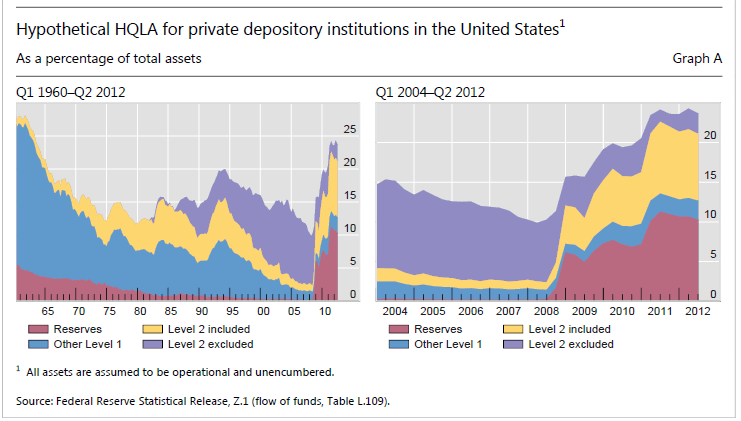Unconventional monetary policies and the LCR
(Extract from page 59 of BIS Quarterly Review, December 2012)
In the aftermath of the financial crisis, several central banks have engaged in substantial open market operations, eg Large-Scale Asset Purchases (LSAP) or quantitative easing (QE), with a view to providing additional monetary stimulus to support the economic recovery.
An interesting thought experiment is to determine how such operations may have impacted the LCR had it already been in place. Unfortunately, while historical data are available on bank assets and liabilities, this is not the case for other data such as contractual in- and outflows and asset encumbrance. Hence, we focus instead on the narrower question of the impact on the stock of HQLA under the assumption that all assets are unencumbered and operational (see Box 1).
Using historical balance sheet data for all private depository institutions in the United States, Graph A shows the stock of "potential" HQLA since 1960.1 The red area refers to the individual contributions from reserves; the blue area to other Level 1 assets; and the yellow area to Level 2 assets included, that is, the amount of these assets below the 40% cap. The purple area shows the amount of Level 2 assets excluded due to the cap. Everything is measured as a percentage of total assets.
The graph shows that the amount of Level 1 and Level 2 assets held by US depository institutions fell from over 25% of assets in 1960 to just over 10% in the runup to the financial crisis. Part of the downward trend in the stock of potential HQLA (the sum of the red, blue and yellow areas) is explained by a move towards holding more Level 2 assets, primarily in the form of agency debentures and mortgage-backed securities. The graph also shows that the interventions by the Federal Reserve have reversed much of the fall in potential HQLA over the previous four decades, with potential HQLA growing to just under 20% of total assets in mid-2012. The rise is driven in part by the increase in reserves, which had the effect of raising both Level 1 assets and the cap on Level 2 assets that can count as HQLA. In addition, banks are likely to have decided to hold a larger stock of liquid assets.
1 Information from the Federal Financial Institutions Examination Council (Call Reports) suggests that roughly one third of securities currently held by US depository institutions are in fact encumbered. Unfortunately, granular and historical information was not readily available for this analysis.

